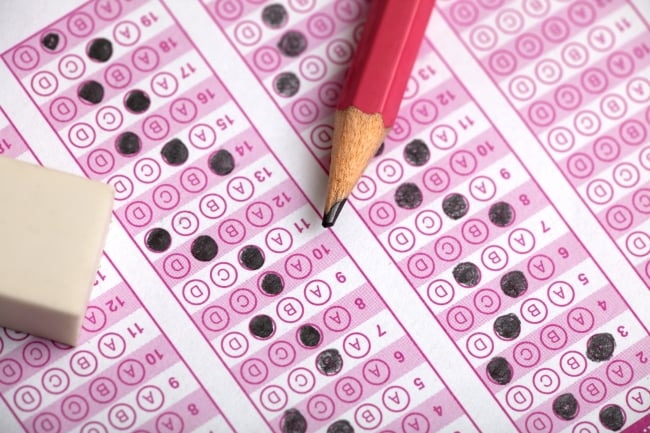You have /5 articles left.
Sign up for a free account or log in.

gece33/iStock/Getty Images Plus
The COVID-19 pandemic forced colleges and universities across the country to do away with standardized test scores as part of their application requirements. The tide, however, seems to be shifting back against test-optional admissions, especially at our most elite institutions.
Three of America’s top private universities—Brown University, Dartmouth College and Yale University—recently decided to return to requiring standardized tests as part of the admissions process, as did one of our top public institutions, University of Texas at Austin. Massachusetts Institute of Technology made this decision in 2022.
The decisions are being defended by two claims: that there is a correlation between test scores and college success and that a test-optional system has actually been a barrier to college access for underrepresented students. Neither of these claims holds up to scrutiny.
Citing research from before and after the pandemic, Yale, for example, asserts that “test scores are the single greatest predictor of a student’s future Yale grades.”
This may well be true, but a lack of academic success at elite universities like Yale is not a looming problem. The mean GPA at Yale for 2022–23 was 3.7.
Jeffrey Selingo, writing in New York magazine, shares some telling data from one unnamed “top-ranked liberal arts college” about the correlation between test scores and grades. Forty percent of the students at that college did not submit test scores, Selingo is told by the dean of admissions, and “the average first-year GPA for members of the freshman class that submitted scores was 3.57; for nonsubmitters it was 3.47.” The dean cites this difference as being “statistically significant.” But the marginal difference in GPA here speaks to a telling fact: nonsubmitters still earned extremely successful grades.
Of course, academic success is not measured solely by GPA. College completion rates are another important factor. Universities want to invest in students who will graduate in a timely fashion.
MIT studied this issue as part of its decision in 2022 to reinstate a standardized test score requirement. MIT admission officer Chris Peterson told Selingo that students with lower SAT math scores (between a 600 and 699) admitted in the early 2000s did not “do well.” Graduation rates at near 90 percent were, as Selingo explains, “not good enough for MIT.” So, MIT doubled down on the requirement of super-high SAT scores.
And while Selingo notes that MIT was able, in subsequent years, to raise the graduation rates, including for African American and Latino students, the university’s diversity dashboard makes clear that students of color remain underrepresented at MIT. From 2005 to 2023, the percentage of enrolled undergraduates who identify as Black increased from 6 percent to 7.8 percent. The number of self-identified Hispanic/Latino undergraduates at MIT increased from 11.5 percent in 2005 to 14.8 percent in 2023. (EDITOR’S NOTE: This paragraph has been updated to reflect undergraduate-only enrollment numbers, while an earlier version included numbers for all MIT students.) Meanwhile, MIT’s current 4-year and 6-year graduation rates stand at 89 percent and 95 percent, respectively.
The second significant claim that institutions have made is that a test-optional policy is a barrier to identifying “less-advantaged students who would succeed.” This is a more complex and problematic claim.
Dartmouth cites research that suggests that without test scores, admissions offices rely more heavily on other factors, like letters of recommendation, that have been shown to be biased toward higher-income students. When test scores are submitted and read in context, according to a faculty committee, “an applicant with an SAT score of 1400 has a higher probability of admission if from a high school where average SAT scores are relatively low. Under a test-optional policy, these students are less likely to be identified and admitted.”
There is no question that the work of college admissions is an incredibly difficult task, and a test-optional admissions environment increases the burden on institutions. In 2021, in the test-optional COVID era, applications at selective institutions soared. Harvard University, for example, saw applications rise 42 percent.
A comment in a 2018 study of 28 institutions that adopted a test-optional approach prior to COVID illustrates the challenge for admissions offices: “When you have a test score that is consistent with the academic record and other documents, it gives you confidence to spend less time on the application. When there’s no test score as ‘confirming’ evidence, you’ll typically look more closely at the high school record, the rigor of the curriculum, and the school profile for context.”
Those institutions in the study that did the challenging admissions work, however, improved access among underrepresented students. Their nonsubmitter students graduated at equivalent or higher rates as test submitters. These institutions did see a rise in financial need among their students, as “nonsubmitters were generally needier than submitters.”
While flagship publics like UT Austin may be different, MIT, Yale, Brown and Dartmouth all have the resources to invest both in their admissions process and in students who need more financial aid.
In other words, Dartmouth’s conclusions about diminished access may say more about their investment in admissions than in the ability of admissions offices to navigate nonsubmitter applications. Rather than going back to standardized tests, which have contributed to overwhelmingly wealthy and white student populations at these institutions, there is a compelling argument that a portion of admissions slots at elite colleges should be allocated by lottery, with some baseline academic qualifications. Journalist Bryan Walsh makes the argument that a “literal lottery” would make more transparent the vast degree of luck involved in the fine discriminations that admission officers make among the many qualified, talented students.
Walsh’s argument underscores the lie at the heart of elite institutions. Students there are smart and work hard. But that’s true of many students at many institutions.
Unlike many institutions, however, our elite institutions can and do devote enormous resources to ensure that students succeed—from no-loan financial aid packages that cover the full cost of attendance (including travel and books, see Princeton University) for low-income students, to opportunities for paid internships, and deep safety nets for when things go wrong.
In other words, the return to standardized test requirements stands to harm precisely the low-income, underrepresented students who would most benefit from the support that only our wealthy, elite institutions can and do provide.
The harm of these tests is insidious.
Standardized tests require preparation for which many students do not have the time and resources. They undermine students’ belief in their ability to succeed at elite institutions. They inhibit students from even applying to elite institutions where they might gain admissions, be well-supported, and achieve academic and professional success.
A return to standardized test requirements with messaging that asks students to understand that their test scores will be read “in context” by admissions committees is not a solution. As Angel B. Pérez, chief executive officer of the National Association for College Admission Counseling, commented, “I have yet to speak to a counselor at a low-income high school who doesn’t believe that test optional has helped open the doors wider for their students.”
With their enormous endowments and proven track records of supporting students not only through college but into successful careers, elite colleges have a responsibility to welcome a wide range of students and to loudly proclaim that students’ standardized test scores do not define their academic potential, professional value or “merit” in our deeply unequal world. Let’s not turn the clock backwards.




